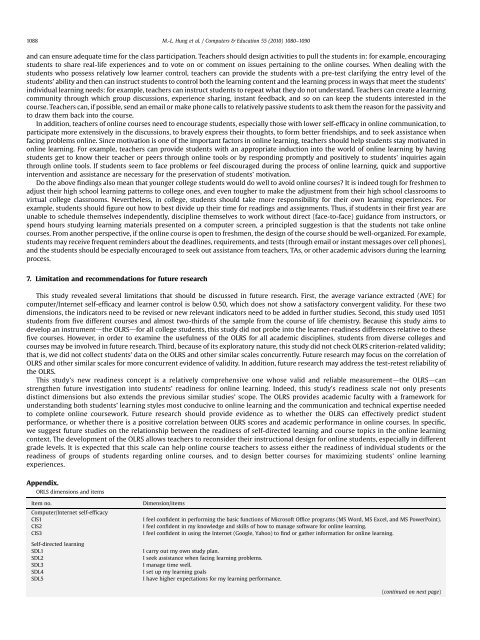Learner readiness for online learning: Scale ... - Anitacrawley.net
Learner readiness for online learning: Scale ... - Anitacrawley.net
Learner readiness for online learning: Scale ... - Anitacrawley.net
Create successful ePaper yourself
Turn your PDF publications into a flip-book with our unique Google optimized e-Paper software.
1088M.-L. Hung et al. / Computers & Education 55 (2010) 1080–1090and can ensure adequate time <strong>for</strong> the class participation. Teachers should design activities to pull the students in: <strong>for</strong> example, encouragingstudents to share real-life experiences and to vote on or comment on issues pertaining to the <strong>online</strong> courses. When dealing with thestudents who possess relatively low learner control, teachers can provide the students with a pre-test clarifying the entry level of thestudents’ ability and then can instruct students to control both the <strong>learning</strong> content and the <strong>learning</strong> process in ways that meet the students’individual <strong>learning</strong> needs: <strong>for</strong> example, teachers can instruct students to repeat what they do not understand. Teachers can create a <strong>learning</strong>community through which group discussions, experience sharing, instant feedback, and so on can keep the students interested in thecourse. Teachers can, if possible, send an email or make phone calls to relatively passive students to ask them the reason <strong>for</strong> the passivity andto draw them back into the course.In addition, teachers of <strong>online</strong> courses need to encourage students, especially those with lower self-efficacy in <strong>online</strong> communication, toparticipate more extensively in the discussions, to bravely express their thoughts, to <strong>for</strong>m better friendships, and to seek assistance whenfacing problems <strong>online</strong>. Since motivation is one of the important factors in <strong>online</strong> <strong>learning</strong>, teachers should help students stay motivated in<strong>online</strong> <strong>learning</strong>. For example, teachers can provide students with an appropriate induction into the world of <strong>online</strong> <strong>learning</strong> by havingstudents get to know their teacher or peers through <strong>online</strong> tools or by responding promptly and positively to students’ inquiries againthrough <strong>online</strong> tools. If students seem to face problems or feel discouraged during the process of <strong>online</strong> <strong>learning</strong>, quick and supportiveintervention and assistance are necessary <strong>for</strong> the preservation of students’ motivation.Do the above findings also mean that younger college students would do well to avoid <strong>online</strong> courses? It is indeed tough <strong>for</strong> freshmen toadjust their high school <strong>learning</strong> patterns to college ones, and even tougher to make the adjustment from their high school classrooms tovirtual college classrooms. Nevertheless, in college, students should take more responsibility <strong>for</strong> their own <strong>learning</strong> experiences. Forexample, students should figure out how to best divide up their time <strong>for</strong> readings and assignments. Thus, if students in their first year areunable to schedule themselves independently, discipline themselves to work without direct (face-to-face) guidance from instructors, orspend hours studying <strong>learning</strong> materials presented on a computer screen, a principled suggestion is that the students not take <strong>online</strong>courses. From another perspective, if the <strong>online</strong> course is open to freshmen, the design of the course should be well-organized. For example,students may receive frequent reminders about the deadlines, requirements, and tests (through email or instant messages over cell phones),and the students should be especially encouraged to seek out assistance from teachers, TAs, or other academic advisors during the <strong>learning</strong>process.7. Limitation and recommendations <strong>for</strong> future researchThis study revealed several limitations that should be discussed in future research. First, the average variance extracted (AVE) <strong>for</strong>computer/Inter<strong>net</strong> self-efficacy and learner control is below 0.50, which does not show a satisfactory convergent validity. For these twodimensions, the indicators need to be revised or new relevant indicators need to be added in further studies. Second, this study used 1051students from five different courses and almost two-thirds of the sample from the course of life chemistry. Because this study aims todevelop an instrumentdthe OLRSd<strong>for</strong> all college students, this study did not probe into the learner-<strong>readiness</strong> differences relative to thesefive courses. However, in order to examine the usefulness of the OLRS <strong>for</strong> all academic disciplines, students from diverse colleges andcourses may be involved in future research. Third, because of its exploratory nature, this study did not check OLRS criterion-related validity;that is, we did not collect students’ data on the OLRS and other similar scales concurrently. Future research may focus on the correlation ofOLRS and other similar scales <strong>for</strong> more concurrent evidence of validity. In addition, future research may address the test-retest reliability ofthe OLRS.This study’s new <strong>readiness</strong> concept is a relatively comprehensive one whose valid and reliable measurementdthe OLRSdcanstrengthen future investigation into students’ <strong>readiness</strong> <strong>for</strong> <strong>online</strong> <strong>learning</strong>. Indeed, this study’s <strong>readiness</strong> scale not only presentsdistinct dimensions but also extends the previous similar studies’ scope. The OLRS provides academic faculty with a framework <strong>for</strong>understanding both students’ <strong>learning</strong> styles most conducive to <strong>online</strong> <strong>learning</strong> and the communication and technical expertise neededto complete <strong>online</strong> coursework. Future research should provide evidence as to whether the OLRS can effectively predict studentper<strong>for</strong>mance, or whether there is a positive correlation between OLRS scores and academic per<strong>for</strong>mance in <strong>online</strong> courses. In specific,we suggest future studies on the relationship between the <strong>readiness</strong> of self-directed <strong>learning</strong> and course topics in the <strong>online</strong> <strong>learning</strong>context. The development of the OLRS allows teachers to reconsider their instructional design <strong>for</strong> <strong>online</strong> students, especially in differentgrade levels. It is expected that this scale can help <strong>online</strong> course teachers to assess either the <strong>readiness</strong> of individual students or the<strong>readiness</strong> of groups of students regarding <strong>online</strong> courses, and to design better courses <strong>for</strong> maximizing students’ <strong>online</strong> <strong>learning</strong>experiences.Appendix.ORLS dimensions and itemsItem no.Computer/Inter<strong>net</strong> self-efficacyCIS1CIS2CIS3Self-directed <strong>learning</strong>SDL1SDL2SDL3SDL4SDL5Dimension/itemsI feel confident in per<strong>for</strong>ming the basic functions of Microsoft Office programs (MS Word, MS Excel, and MS PowerPoint).I feel confident in my knowledge and skills of how to manage software <strong>for</strong> <strong>online</strong> <strong>learning</strong>.I feel confident in using the Inter<strong>net</strong> (Google, Yahoo) to find or gather in<strong>for</strong>mation <strong>for</strong> <strong>online</strong> <strong>learning</strong>.I carry out my own study plan.I seek assistance when facing <strong>learning</strong> problems.I manage time well.I set up my <strong>learning</strong> goalsI have higher expectations <strong>for</strong> my <strong>learning</strong> per<strong>for</strong>mance.(continued on next page)
















